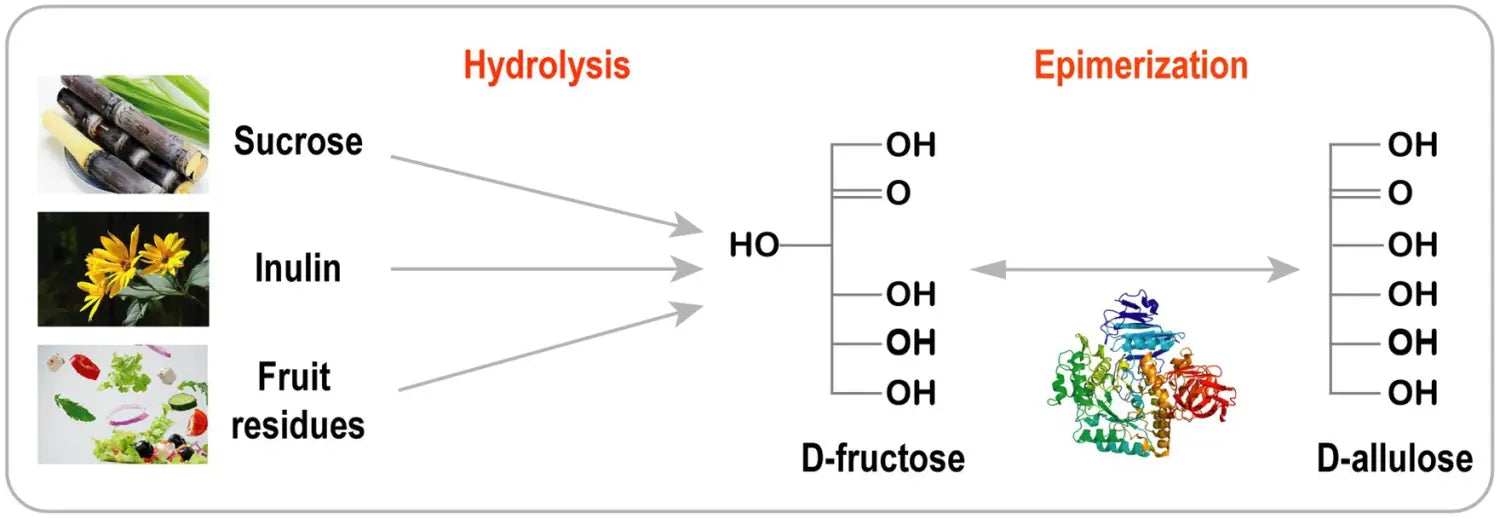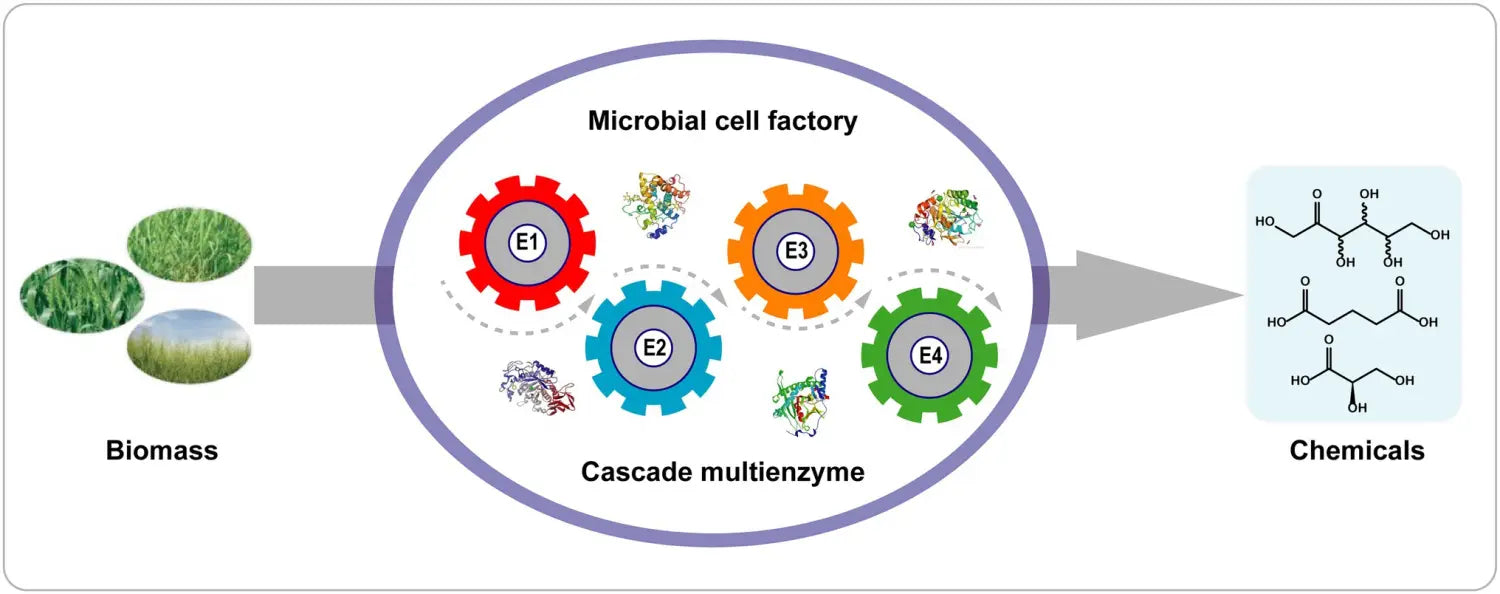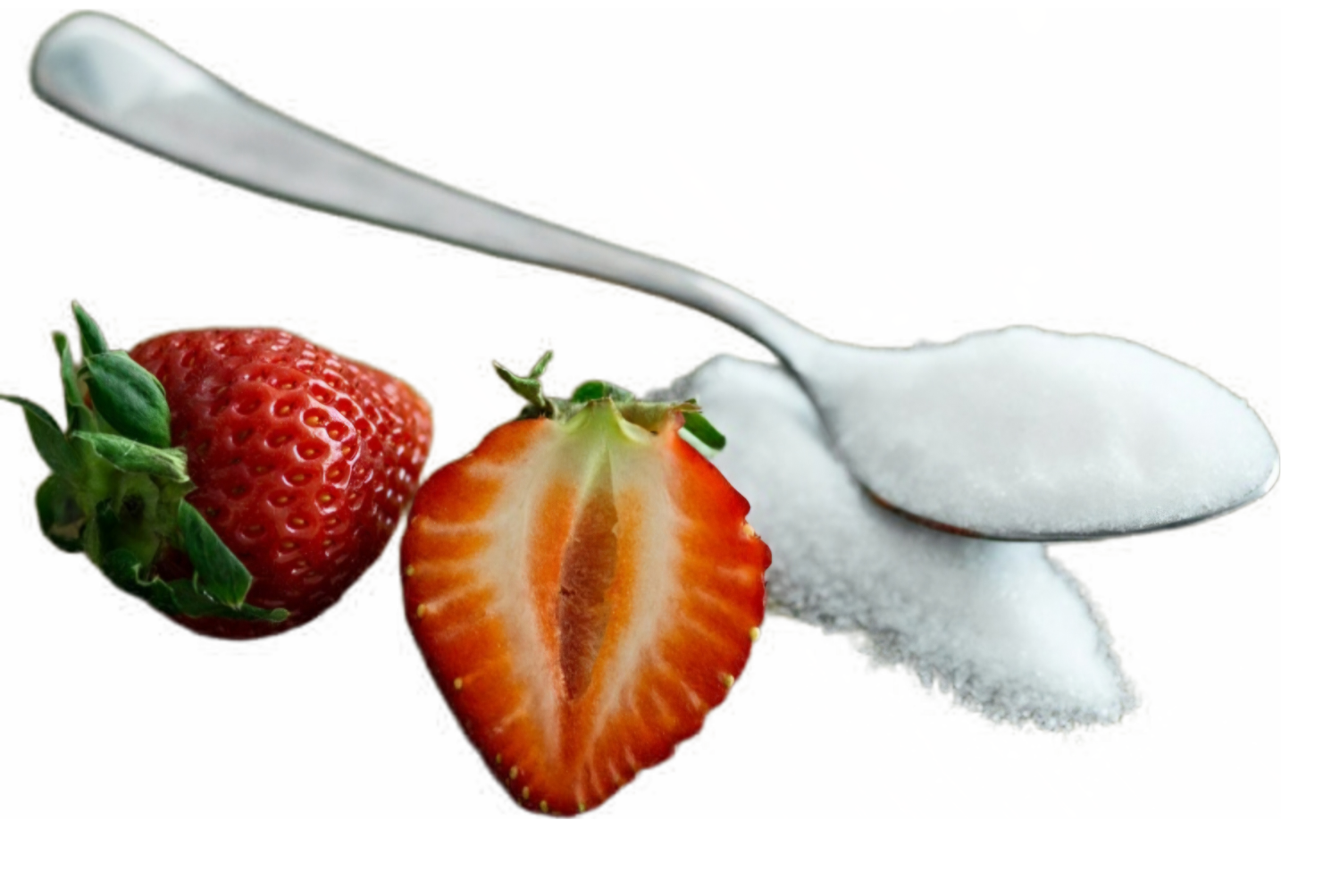
Recent findings on the physiological functions and biosynthesis of D-allulose
Allulose StoreSource: frontiers
Food Microbiology
Volume 13 - 2022 | https://doi.org/10.3389/fmicb.2022.881037
This article is part of the research topic ' Innovative microbial technologies for future and sustainable food science'
Recent findings on the physiological functions and biosynthesis of D-allulose
- Key Laboratory of Carbohydrate Chemistry and Biotechnology, Ministry of Education, School of Biotechnology, Jiangnan University, Wuxi, China
D-Allulose, a sugar generally recognized as safe (GRAS), is rare in nature.
Its low calorie content, sucrose-like taste, and unique functions make it one of the most promising sweeteners for future use.
D-allulose has many physiological effects, such as anti-obesity, anti-hyperglycemia, anti-diabetic, anti-inflammatory, antioxidant, and neuroprotective effects.
Therefore, D-allulose has important application value in the food industry, pharmaceutical industry and healthcare.
However, the high cost of producing D-allulose limits its large-scale application. Currently, biotransformation is very attractive for the synthesis of D-allulose, with the two main methods of biosynthesis being the Izumoring strategy and the DHAP-dependent aldolase strategy.
This article reviews the latest findings on the physiological functions and biosynthesis of D-allulose. It also presents the future prospects for the production of D-allulose.
Introduction
Recently, the risk of obesity, hyperlipidemia, hypertension, and diabetes has rapidly increased worldwide due to the excessive intake of nutritious diets high in fat and sugar.
Sucrose, a traditional food sweetener, plays an important role in the food industry due to its sweetness and palatability ( Castro-Muñoz et al., 2022 ).
However, sucrose has some disadvantages, such as its high calorie content, its ability to induce hyperglycemic reactions, and diabetes ( Grassi et al., 2021 ).
Therefore, low-calorie sweetener substitutes have attracted the interest of researchers ( Khan et al., 2021 ).
More than 30 types of rare sugars have been reported ( Granström et al., 2004 ). They have unique biological functions and are used as food additives, cancer cell suppressors, and building blocks for anticancer and antiviral drugs ( Zhang et al., 2016b ; Li et al., 2017 ; Guerrero-Wyss et al., 2018 ; Hoshikawa et al., 2018 ; Xia et al., 2021 ).
D -allulose (also known as D-psicose) is the most notable of the rare sugars.
More than 20 years have passed since Ken Izumori first reported D-allulose ( Itoh et al., 1995 ).
It has 70% of its sweetness, but only 0.3% of its energy content, as sucrose.
Additionally, it contains almost no calories ( Matsuo et al., 2002 ).
As an industrially important bioproduct, D-allulose was listed as a “generally recognized as safe” (GRAS) substance by the U.S. Food and Drug Administration (FDA) in 2002 and approved for use in confectionery, fruit juices, dietary supplements, and other dietary products.
Therefore, D-allulose has important application value in the food industry, pharmaceutical industry and healthcare.
D-Allulose is expected to change the sweetener market due to its low calorie content and palatability, as it will be able to compete with other sugar substitutes (sugar alcohols such as xylitol, mannitol, and sorbitol).
The commercial price of D-allulose is expected to approach that of competing sugar substitute sweeteners such as xylitol (2–5 USD/kg), mannitol (1–5 USD/kg), and sorbitol (1–10 USD/kg).
D-Allulose will become competitive in large-scale production in the near future, similar to other sweeteners with annual consumption of millions of tons.
Currently, factors limiting the release and price of D-allulose include the high cost of starting materials, low yields, and difficulty in isolation.
In this article, we summarize and discuss recent findings on the physiological functions and biosynthesis of D-allulose.
Physiological functions of D-allulose
The effect of D-allulose on lipid metabolism
D-allulose has been shown to have anti-obesity effects in animals and humans by reducing food intake, fat mass, and adipose tissue weight ( Kimura et al., 2017 ; Bilal et al., 2018 ).
Additionally, several lines of evidence suggest that D-allulose can increase energy expenditure and reduce fat deposition in normal rats ( Chung et al., 2012 ; Ochiai et al., 2014 ).
Although D-allulose may reduce adipose tissue weight, the mechanism remains unknown.
It can reduce fatty acid synthase (FSA) activity and increase β-oxidation and carnitine palmitoyltransferase (CPT) activity in epididymal white adipose tissue (WAT; Han et al., 2016 ).
Furthermore, dietary D-allulose can inhibit the expression of lipogenesis-related acetyl-CoA carboxylase alpha (ACCα) in epididymal WAT.
In addition, dietary D-allulose can stimulate the expression of fatty acid oxidation-related AMP-activated protein kinase alpha 2 (AMPKα2), hormone-sensitive lipase (HSL), and peroxisome proliferator-activated receptor alpha (PPARα; Chen et al., 2019 ). Therefore, D-allulose has potential anti-obesity properties .
Antihyperglycemic effect of D-allulose
Poor nutrition has led to a rapid increase in the incidence of obesity and obesity-related type 2 diabetes (T2DM) worldwide, significantly increasing the costs of treating these chronic diseases.
Therefore, it is very important to identify effective therapeutic interventions for the treatment of diabetes and its complications. D-allulose has received much attention due to its promising antihyperglycemic properties, as it can regulate plasma glucose levels, body weight, and fat mass ( Matsuo and Izumori, 2009 ; Hossain et al., 2015 ; Lee et al., 2020 ).
However, the mechanism of its antidiabetic effect remains unclear. It is hypothesized that D-allulose affects blood sugar levels and insulin secretion, or the activity of glucosidase and lipolytic enzymes.
D-allulose has been shown to significantly inhibit the increase in plasma glucose concentration induced by sucrose or maltose ( Matsuo and Izumori, 2009 ).
Additionally, D-allulose has been shown to effectively inhibit intestinal sucrase and maltase activity.
The addition of D-allulose (5 g) can significantly suppress the blood glucose increase induced by oral maltodextrin (75 g) in normal adults.
Furthermore, oral D-allulose alone does not affect blood glucose and insulin levels ( Iida et al., 2008 ).
D-allulose has also been shown to inhibit postprandial blood glucose elevation, especially in patients with borderline diabetes, and no side effects or clinical problems were observed after 12 weeks of continuous D-allulose intake ( Hayashi et al., 2010 ).
Although several studies have shown that D-allulose has antidiabetic activity, the mechanism is not yet fully understood.
In the liver, D-glucose metabolism is regulated by the nucleocytoplasmic shift of glucokinase ( Hossain et al., 2015 ).
At low glucose levels, glucokinase remains in an inactive form bound to glucokinase regulatory protein (GKRP), which is recruited to the nucleus of the hepatocyte. When glucose levels reach high levels, glucokinase is activated by dissociation from the glucokinase-GKRP complex and translocates from the nucleus to the cytoplasm, where it participates in glycogen metabolism and blood glucose homeostasis ( Liu et al., 2012 ).
For example, activation of glucokinase can improve glucose tolerance and insulin sensitivity ( Shintani et al., 2017b ).
Impaired hepatic glucokinase function leads to the pathogenesis of hyperglycemia in diabetes ( Basu et al., 2001 ).
Therefore, glucokinase is considered a potential target for antidiabetic drugs ( Lloyd et al., 2013 ).
In addition, glucokinase is activated by several fructose phosphates, such as fructose-6-phosphate (F6P) and fructose-1-phosphate (F1P; Pfefferkorn, 2013 ).
D-allulose-1-phosphate, like fructose-1-phosphate, also activates glucokinase. Therefore, D-allulose may increase hepatic glucose utilization ( Toyoda et al., 2010 ).
Glucose-6-phosphatase (G6Pase) contributes to hyperglycemia in diabetes and regulates the rate-determining steps of hepatic gluconeogenesis flux ( Herling et al., 1998 ).
D-allulose can regulate blood sugar levels and exert hypolipidemic effects by reducing G6Pase activity ( Nagata et al., 2015 ).
It has been reported that oral administration of D-allulose can stimulate GLP-1 secretion and thus can be used for the prevention and treatment of glucose intolerance ( Hayakawa et al., 2018 ).
It has recently been confirmed that D-allulose induces GLP-1 release, activates vagal afferent signaling, reduces food intake, and limits hyperglycemia in healthy and obese diabetic rats.
Furthermore, oral D-allulose may correct arrhythmic overeating, obesity, and diabetes ( Iwasaki et al., 2018 ).
Other physiological functions of D-allulose
D-allulose exerts anti-inflammatory effects by suppressing serum levels of pro-inflammatory cytokines such as tumor necrosis factor-alpha (TNF-α), interleukin-6 (IL-6), and monocyte chemoattractant protein 1 (MCP-1). These cytokines are mainly derived from visceral adipose tissue ( Moller and Berger, 2003 ; Kim et al., 2017 ).
D-allulose also has antioxidant effects, protecting against 6-hydroxydopamine-induced apoptosis or preventing testicular damage by scavenging reactive oxygen species (ROS) ( Takata et al., 2005 ; Suna et al., 2007 ).
D-allulose may also extend lifespan by increasing the activities of superoxide dismutase (SOD) and catalase (CAT) ( Shintani et al., 2017a ).
Furthermore, D-allulose has been shown to alter serum cholesterol levels in hamsters, in part by reducing the levels of the proprotein convertase subtilisin/kexin type 9 (Pcsk9) ( Kanasaki et al., 2019 ).
Furthermore, D-allulose can improve systemic and muscle insulin sensitivity in awake rats ( Natsume et al., 2021). The various physiological functions of D-allulose illustrated in Figure 1 .
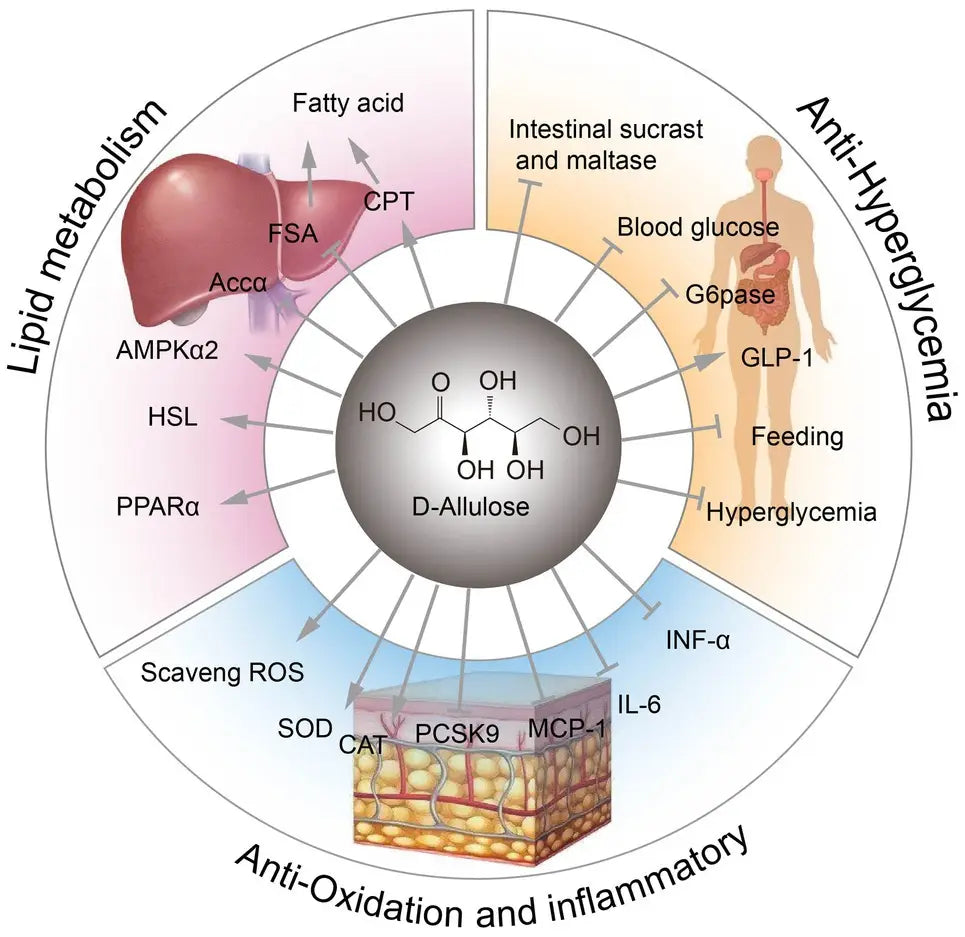
Figure 1. Physiological functions of D-allulose. FSA, fatty acid synthase; CPT, carnitine palmitoyltransferase; ACCα, acetyl-CoA carboxylase alpha; AMPKα, AMP-activated protein kinase alpha; HSL, hormone-sensitive lipase; PPARα, peroxisome proliferator-activated receptor alpha; ROS, reactive oxygen species; SOD, superoxide dismutase; CAT, catalase activity; Pcsk9, proprotein convertase subtilisin/kexin type 9; MCP-1, monocyte chemoattractant protein 1; G6Pase, glucose-6-phosphatase.
Biological production of D-allulose
As described above, D-allulose has many useful physiological functions. However, D-allulose is rare in nature, which greatly limits its widespread application. The traditional chemical synthesis of D-allulose usually involves cumbersome reactions and numerous side reactions ( McDonald, 1967 ; Doner, 1979 ).
It is difficult to produce a single product configuration using chemical methods.
In contrast, bioconversion approaches have several advantages, including mild reaction conditions, few byproducts, simple purification steps, and environmentally friendly properties ( Zhang et al., 2021 ).
Therefore, biotransformation has gradually become the main method for D-allulose synthesis.
Currently, the biological production of D-allulose is mainly achieved by two strategies : (1) the Izumoring strategy and (2) the DHAP-dependent aldolase strategy.
Production of D-allulose using Izumoring strategy
Production of D-allulose from D-fructose using enzymes of the D-tagatose 3-epimerase family
The Izumoring strategy is a promising approach for the bioproduction of any hexose sugar and involves D-tagatose-3-epimerases (DTEases), polyol dehydrogenases and aldose isomerases ( Izumori, 2006 ).
In recent decades, the Izumoring strategy has proven effective in the biosynthesis of rare sugars.
Enzymes belonging to the DTEase family are key enzymes for the biosynthesis of D-allulose from D-fructose ( Figure 2 ), and include DTEase and D-allulose-3-epimerase (DAEase).
DAEase shows greater specificity for D-allulose than for D-tagatose ( Kim et al., 2006 ).
Since the identification of the first DTEase from Pseudomonas cichorii ST-24 in 1993, other DTEase enzymes have been isolated from various species, such as Agrobacterium tumefaciens ( Kim et al., 2006 ), Clostridium Bolteae ( Jia et al., 2014 ), Dorea sp. CAG317 ( Zhang et al., 2015 ), Ruminococcus sp. 5_1_39BFAA ( Chen et al., 2016 ), Treponema primitia ZAS-1 ( Zhang et al., 2016c ), Rhodobacter sphaeroides ( Qi et al., 2017 ), Ruminococcus sp. ( Li et al., 2018 ), Arthrobacter globiformis M30 ( Yoshihara et al., 2017 ), Clostridium cellulolyticum H10 ( Su et al., 2018 ), Sinorhizobium sp. ( Zhu et al., 2019b ), and Rhodopirellula baltica SH 1 ( Zhang et al., 2020 ). Details of the catalytic properties of enzymes belonging to the DTEase family from different species are presented in Table 1 . Itoh et al. (1995) first reported the immobilization of DTEase from P. cichorii on chitopearl beads and produced 90 g of D-allulose from 500 g of D-fructose.
Since then, DTEase immobilization methods have attracted widespread interest ( Lim et al., 2009 ; Tseng et al., 2014 ; Narayan Patel et al., 2018 ), and the immobilized enzymes have shown improved thermal stability and storage stability.
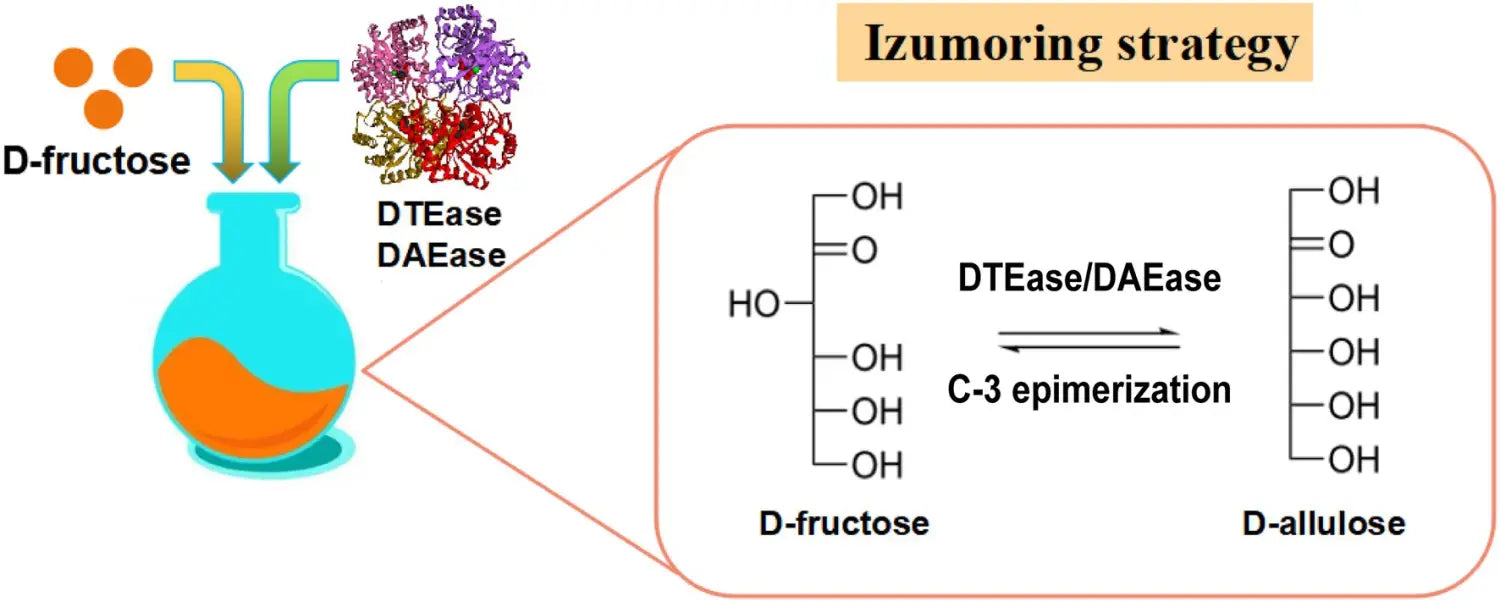
Figure 2. Isomoring strategy for the production of D-allulose. DTEase, D-tagatose-3-epimerase; DAEase, D-allulose-3-epime
Biosynthesis of D-allulose from inexpensive materials based on DTEase enzymes
Currently, agricultural by-products, such as fruit and vegetable residues, cause significant agricultural problems ( Lai et al., 2017 ).
Agricultural residues are usually buried in landfills or incinerated ( Park and Yoon, 2015 ). However, these residues contain large amounts of dietary fiber and sugars, including sucrose, D-glucose, and D-fructose.
The conversion of dietary fibers and sugars into high value-added products is a significant step towards alleviating agricultural problems.
Cascade catalysis is considered a very attractive approach compared to traditional step-by-step synthesis.
This strategy is often used to produce rare sugars from inexpensive materials such as sucrose, Jerusalem artichoke, inulin, and fruit/vegetable residues ( Figure 3 ; Wagner et al., 2015 ; Song et al., 2016 , 2017 ; Zhang et al., 2017 ; Yang et al., 2019 ; Li et al., 2020a ).
D-allulose was efficiently synthesized from sucrose using purified recombinant invertase, D-xylose isomerase, and DTEase.
Furthermore, a practical integration of cascade solution and simulated moving bed (SMB) chromatography was used to produce pure D-allulose (99.9%) in very high yield (89%; Wagner et al., 2015 ).
D-allulose can also be synthesized through a two-step cascade reaction involving Jerusalem artichoke hydrolysis ( Song et al., 2017 ), cruciferous plant residues ( Song et al., 2016 ), and inulin ( Li et al., 2020a ).
To reduce production costs and avoid enzyme purification, Zhu and co-workers developed a one-step, two-enzyme reaction system using a novel exo-inulinase derived from Bacillus velezensis (BvInu) and with DAEase from Ruminococcus sp. for the production of Jerusalem artichoke D-allulose.
BvInu and DAEase were expressed in Bacillus subtilis and secreted into the supernatant without purification. At the optimal BvInu/RDAE ratio (80:40 U/g inulin), 10.3 g/L D-allulose was obtained from 50 g/L inulin at 50°C for 2 h ( Zhu et al., 2020 ).
Biosynthesis of D-allulose using microorganisms
Compared with single-step cascade reactions, whole-cell biocatalytic reactions have several advantages ( Figure 4 ): (1) Enzyme-containing cells can be easily prepared without laborious enzyme purification; (2) the cellular context provides a suitable microenvironment and cofactor regeneration (ATP, NAD + /NADH); (3) cell walls and membranes protect enzymes from harsh reaction conditions; and (4) colocalization of multiple enzymes within cells increases the local concentration of enzymes and reduces the diffusion of intermediates in cascade reactions ( Wu and Li, 2018 ).
Modified Escherichia coli is one of the most commonly used organisms for the production of D-allulose, due to its clean background, rapid growth rate, easy culture, and stable genetics.
DAEase and D-glucose isomerase (GIase) from Acidothermus cellulolyticus were co-expressed to produce D-allulose from D-glucose ( Zhang et al., 2017 ).
Similarly, DAEase and xylose isomerase (XI) were co-expressed to produce D-allulose using D-glucose as a substrate ( Chen et al., 2017 ).
In the above two approaches, D-glucose was first converted to D-fructose by GIase or XI, and then D-fructose was immediately isomerized to D-allulose by DAEase.
Although good productivity was achieved by manipulating E. coli , which was not applicable in the food industry due to endotoxins and its non-food grade classification, DAEase has been successfully expressed in several food-safe strains to date, such as B. subtilis , Saccharomyces cerevisiae , and Corynebacterium glutamicum ( Li et al., 2015b ; He et al., 2016 ). He et al. (2016) Clostridium scindens ATCC 35704 DTEase was displayed on the surface of B. subtilis spores to produce D-allulose from D-fructose. The DAEase was linked to the C-terminus of CotZ and showed high thermal stability. After five cycles of use, 60% activity was retained ( He et al., 2016 ).
In our previous study, we developed a spore surface display technique for the production of D-allulose from D-glucose. In this approach, the key enzyme XI of Thermus thermophilus and the DAEase of A. tumefaciens were immobilized on S. cerevisiae spores by biological and chemical methods, respectively ( Li et al., 2015b ).
In addition, multiple DAEases and invertase (INV) were overexpressed in C. glutamicum , and the modified cells immobilized with alginate were subjected to a cascade reaction in a one-step, two-step reaction system to produce D-allulose from sugarcane molasses. After 8 h of reaction, 61.2 g/L of D-allulose was obtained, accounting for 17.4% of the total monosaccharide ( Yang et al., 2019 ).
Currently, the Izumoring strategy is the main method for the industrial production of D-allulose, which can be achieved by using SMB. In addition, the separated D-fructose can be reused to produce D-allulose. In short, the Izumoring strategy is the simplest and most common way to biosynthesize D-allulose. However, the limitations of thermodynamic equilibrium are a bottleneck that limits the widespread application of D-allulose in the food industry.
Production of D-allulose using DHAP-dependent aldolases
As mentioned above, various approaches based on the Izumoring strategy have been developed to produce D-allulose from inexpensive starting materials such as Jerusalem artichoke, inulin, and agricultural residues.
However, the reaction catalyzed by the key enzyme DAEase is reversible and the conversion rate is low, leading to the high price of the resulting D-allulose. In addition, most of the strains used in the synthesis of D-allulose are not GRAS microorganisms.
Therefore, it is of utmost importance to establish a cost-effective and safe platform for mass production of D-allulose.
Stereoselective aldol additions catalyzed by aldolases have become an essential tool in the asymmetric synthesis of CC ( Iturrate et al., 2010 ).
Among the members of the aldolase family, DHAP-dependent aldolases are the most widely used in the synthesis of many carbohydrate compounds that are difficult to synthesize by traditional chemical methods ( Bosshart et al., 2013 ).
There are four types of DHAP-dependent aldolases: L-rhamnulose-1-phosphate aldolase (RhaD), L-fuculose-1-phosphate aldolase (FucA), D-fructose-1,6-bisphosphate aldolase (FruA), and D-tagatose-1,6-bisphosphate aldolase (TagA).
The stereoselective aldol reactions of these four aldolases are complementary. Theoretically, a set of four ketoses can be produced by using DHAP as a donor and the same aldehyde as a receptor ( Gustavo, 2000 ).
Therefore, DHAP-dependent aldolases are well suited for the synthesis of various rare sugars (including D-allulose, D-sorbose, D-tagatose, and L-fructose) due to their unique stereoselectivity ( Figure 5 ; Brovetto et al., 2011 ; Dai et al., 2021
Biosynthesis of D-allulose by RhaD aldolase, D-glyceraldehyde acceptor
A major drawback of DHAP-dependent aldolase strategies is that the donor substrate, DHAP, is very expensive and unstable for large-scale synthesis ( Schümperli et al., 2007 ).
However, there are several ways to synthesize DHAP through enzymatic strategies . For example, DHAP can be produced via dihydroxyacetone (DHA), glycerol or glycerol-3-phosphate , or via metabolic pathways from a cheap feedstock such as glucose or glycerol ( Figure 6 ; Sánchez-Moreno et al., 2004 ; Li et al., 2012 , 2015a ; Wei et al., 2015 ; Yang et al., 2015 , 2016 ).
The artificially modified E. coli, the aldol reaction catalyzed by RhaD was used to synthesize rare sugars (D-allulose and D-sorbose) using glucose as a carbon source and continuous addition of D-glyceraldehyde to the medium. After optimizing the fermentation conditions, the isolated yield of D-allulose and D-sorbose was 0.21 mol/mol D-glyceraldehyde ( Wei et al., 2015 ). D-allulose and D-sorbose are considered GRAS It was produced in C. glutamicum strain using glucose and D-glyceraldehyde as starting materials. Recombinant C. glutamicum strains carrying RhaD and fructose-1-phosphatase (YqaB) were found to accumulate 19.5 g/L D-sorbose and 13.4 g/L D-allulose in batch fermentation ( Yang et al., 2015 ). In addition, D-allulose and D-sorbose were produced in a recombinant E. coli strain that overproduces RhaD and YqaB aldolase by fermentation from glycerol. After 15 h of fermentation, the concentrations of D-sorbose (1.6 g/L) and D-allulose (1.23 g/L) in the supernatant were determined ( Li et al., 2015a ). Recently, our group constructed an efficient system for the whole-cell cascade synthesis of D-sorbose and D-allulose from glycerol and D-glyceraldehyde, which yielded 15.3 g/L D-sorbose and 6.4 g/L D-allulose during batch biotransformation ( Chen et al., 2020a ).
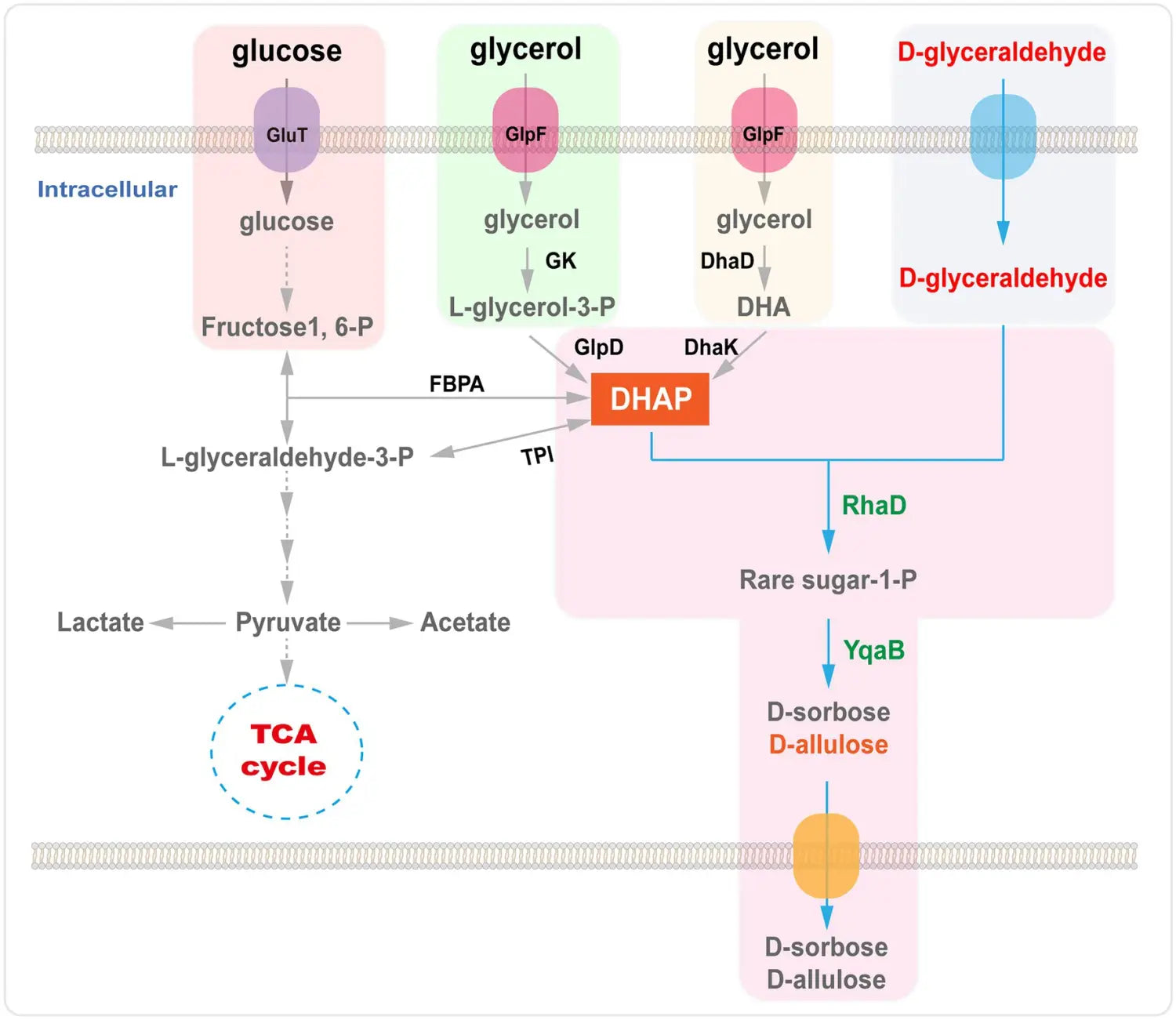
Figure 6. Biosynthesis of D-allulose by RhaD aldolase from glycerol or glucose. GlpF, glycerol transporter; GK, glycerol kinase; GlpD, glycerol-3-phosphate dehydrogenase; DhaD, glycerol dehydrogenase; DhaK, dihydroxyacetone kinases; FBPA, fructose-1,6-diphosphate aldolase; TPI, triose phosphate isomerase; RhaD, L-rhamnulose-1-phosphate aldolase; YqaB, fructose-1-phosphatase.
Biosynthesis of D-allulose from glycerol as the sole substrate
A microbial platform based on the RhaD aldolase for the synthesis of D-allulose would be promising for large-scale production. The main challenge is the high cost of the donor substrate DHAP and the acceptor molecule D-glyceraldehyde. Fortunately, the problem of DHAP accumulation has been solved by using the cheap industrial by-product glycerol as a “green” carbon source. Thus, the next question is to identify a new enzyme that converts low-value glycerol to D-glyceraldehyde. A glycerol dehydrogenase or glycerol oxidase that can efficiently catalyze the conversion of glycerol to D-glyceraldehyde is needed.
To address this issue, our group has developed a platform for the whole-cell cascade synthesis of D-sorbose and D-allulose using glycerol as the sole substrate. In this system ( Figure 7 ), the donor substrate, DHAP, is generated via the glycerol assimilation pathway, and endogenous DHAP is produced by overexpression of glycerol kinase (GK) and glycerol phosphate oxidase (GPO) . The acceptor D-glyceraldehyde is directly produced from glycerol by the alditol oxidase of Streptomyces coelicolor A3 (AldO S.coe ). RhaD then catalyzes the aldol reaction between DHAP and D-glyceraldehyde to produce the corresponding ketose-1-phosphate. Finally, D-sorbose and D-allulose are obtained by removal of the phosphate group by the phosphatase YqaB. With this system, the production yields of D-sorbose and D-allulose increased by approximately 1.7-fold and 1.2-fold, respectively, after overproduction of peroxidase (Prx02 or KatE) to eliminate the detrimental effects of H₂O₂. A total of 7.9 g/L of D-sorbose and D-allulose were obtained from glycerol, with a total conversion rate of 17.7% ( Chen et al., 2020b ).
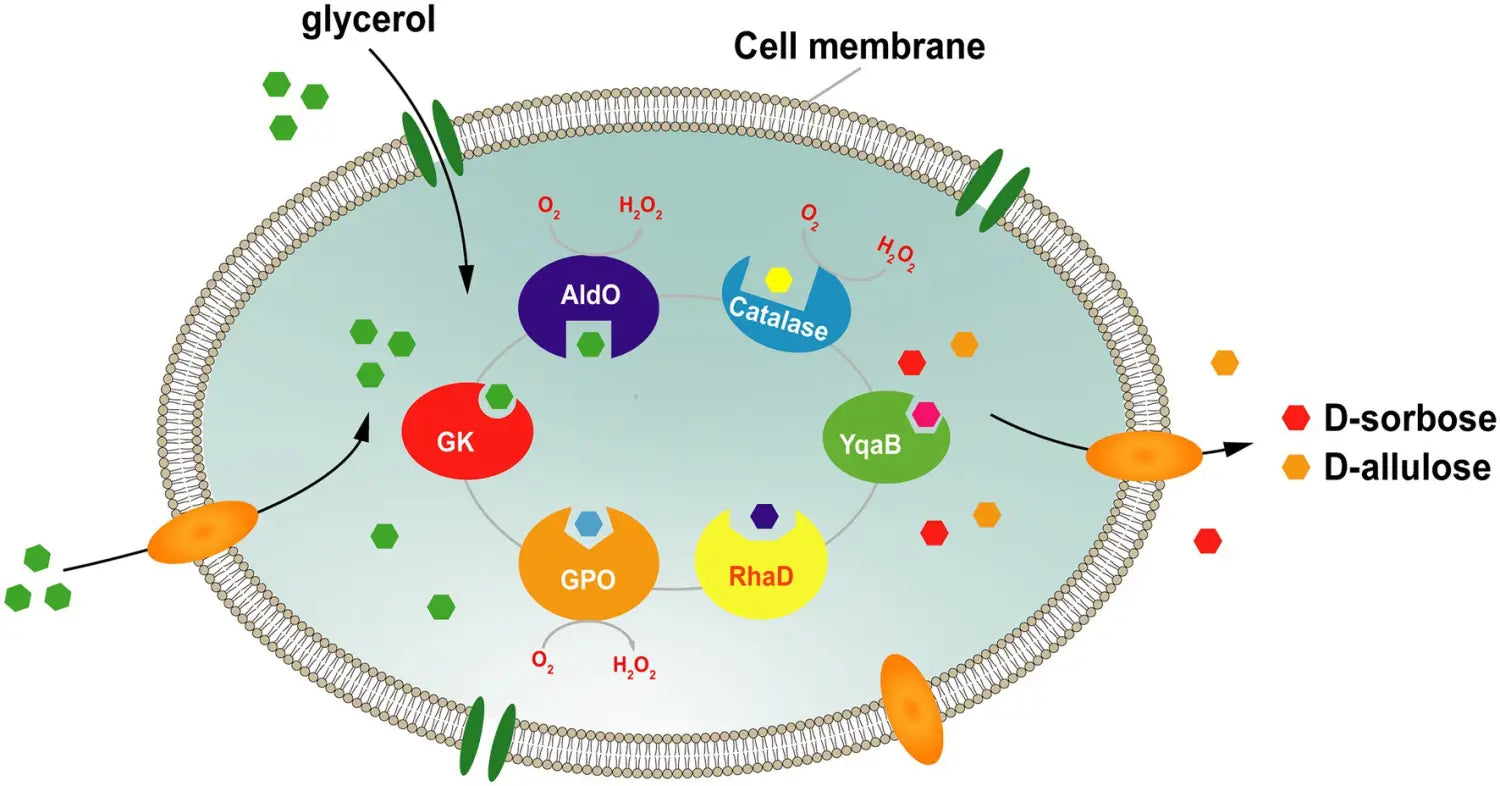
Figure 7. Strategy for the total cellular synthesis of D-sorbose and D-allulose from glycerol. GK, glycerol kinase; GPO, glycerol oxidase; AldO; alditol oxidase; RhaD, L-rhamnulose-1-phosphate aldolase; YqaB, fructose-1-phosphatase.
Our group also constructed a one-step multienzyme system for the synthesis of D-sorbose and D-allulose from glycerol as a single carbon source ( Figure 8 ). Here, we introduced the PhoN acid phosphatase (PhoN-Sf) from Shigella flexneri into the system instead of GK and YqaB, which catalyzed the phosphorylation reaction of glycerol in the first step and helped recycle the phosphate of ketose-1-phosphate in the last step, providing free rare sugar molecules. AldO S.coe was introduced into the above multienzyme cascade to synthesize D-sorbose and D-allulose exclusively from the readily available glycerol. Finally, 14.8 g/L of D-sorbose and D-allulose were obtained from glycerol ( Li et al., 2020b ). The above strategy represents a very useful and low-cost approach for the production of various other rare sugars as well. In a word, the biosynthesis of D-allulose by fermentation based on DHAP-dependent aldolases is very promising. It would be more profitable to build a cell factory based on DHAP-dependent aldolase strategy for the synthesis of D-allulose.
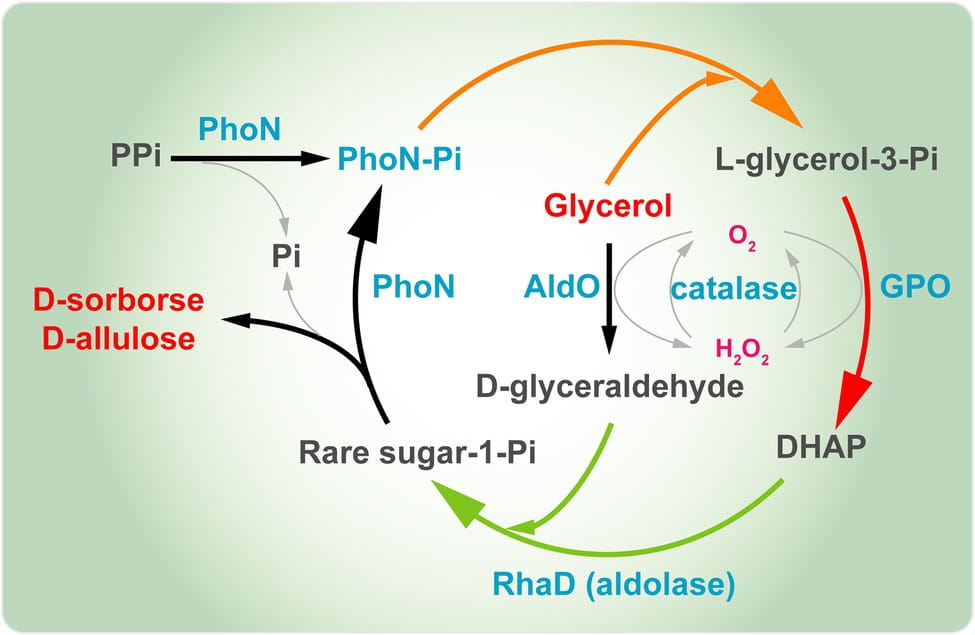
Figure 8. Multienzyme synthesis of D-sorbose and D-allulose from glycerol. PhoN, acid phosphatase; GPO, glycerol oxidase; AldO, alditol oxidase; RhaD, L-rhamnulose-1-phosphate aldolase; DHAP, dihydroxyacetone phosphate.
Thermodynamically controlled production of D-allulose based on a phosphorylation-dephosphorylation strategy
In fact, the above strategies still cannot meet the demand of D-allulose in the food industry. Therefore, it is interesting to develop a new strategy for producing D-allulose, which involves highly efficient and low-cost green bioproduction. Recently, You and co-workers established an in vitro synthetic enzymatic biosystem for producing D-allulose from cheap starch based on the “thermodynamically driven strategy” ( Figure 9 ). This in vitro biosystem included five main enzymes, the reactions proceed as follows: (1) maltodextrin (a starch derivative) was phosphorylated to produce glucose-1-phosphate (G1P) by α-glucan phosphorylase (αGP) with phosphate as a co-substrate. (2) G1P was converted to glucose-6-phosphate (G6P), which was catalyzed by phosphoglucomutase (PGM). (3) G6P was converted to fructose-6-phosphate (F6P), which was catalyzed by phosphoglucose isomerase (PGI). (4) Epimerization of F6P resulted in the production of D-allulose-6-phosphate (A6P), which was catalyzed by D-allulose-6-phosphate 3-epimerase (A6PE). (5) Dephosphorylation of A6P resulted in the production of D-allulose and phosphate, which was catalyzed by D-allulose-6-phosphate phosphatase (A6PP). In addition, the other four auxiliary enzymes [isoamylase (IA), 4-α-glucanotransferase (4GT), polyphosphate glucokinase (PPGK), and glucose isomerase (GI)] were added to the reaction system at different times to achieve the full utilization of maltodextrin to produce D-allulose. In this biosystem, the Gibbs energy of dephosphorylation of A6P to D-allulose is -15.5 kJ/mol, which is irreversible, indicating that the dephosphorylation step required for the production of D-allulose is thermodynamically favorable and unidirectional to drive the overall reaction towards completion. After optimizing the reaction conditions, the production yields of D-allulose from 10 and 50 g/L starch reached 88.2% and 79.2%, respectively ( Li et al., 2021 ). Overall, this thermodynamically driven strategy offers a promising alternative for the cost-effective production of D-allulose. Since the system contains multiple enzymes and the enzyme purification steps are cumbersome, the above strategy still cannot meet the needs of industrialization.
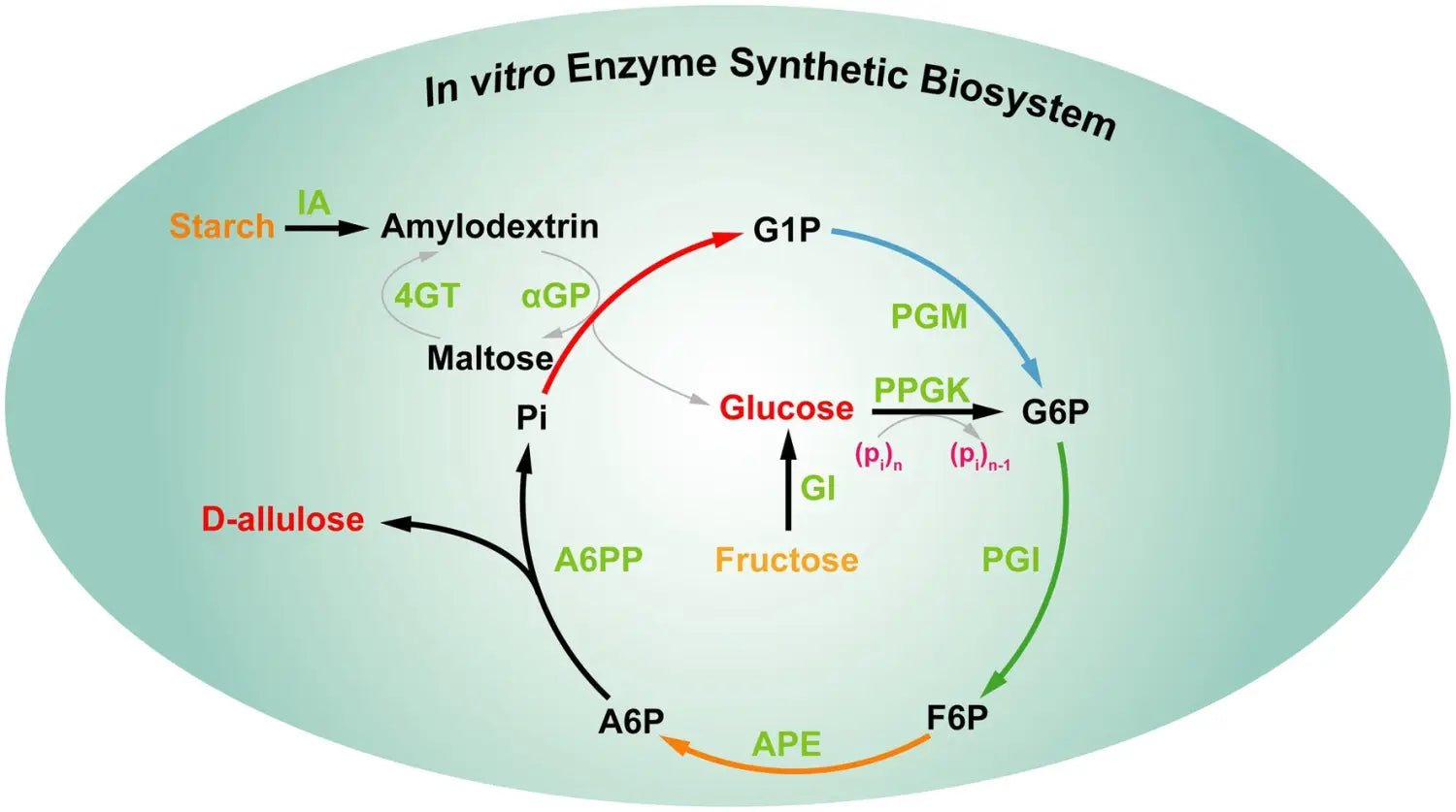
Figure 9. In vitro multienzyme synthesis of D-allulose from starch. IA, isoamylase; 4GT, 4-α-glucanotransferase; αGP, α-glucan phosphorylase; PGM, phosphoglucomutase; PPGK, polyphosphate glucokinase; PGI, phosphoglucose isomerase; GI, glucose isomerase; APE, D-allulose-6-phosphate-3-epimerase; A6PP, D-allulose-6-phosphate phosphatase; G1P, glucose-1-phosphate; G6P, glucose-6-phosphate; F6P, fructose-6-phosphate; A6P, D-allulose-6-phosphate.
Summary and future prospects
The most common method for producing D-allulose is based on the Izumoring strategy, which is limited by thermodynamic equilibrium, resulting in low conversion rates and relatively high synthetic costs.
Therefore, new and robust DTEase family enzymes need to be discovered. Furthermore, the strategy of directed evolution is needed. ( Zhang et al., 2016a ; Zhu et al., 2019a ) or enzyme immobilization ( Ran et al., 2019 ; Wong et al., 2020 )
Improving the catalytic performance of DTEase will be very useful. For the DHAP-dependent aldolase strategy, D-allulose and D-sorbose are produced simultaneously with RhaD, a D-glycerol aldehyde acceptor. Several advanced techniques and methods, including directed evolution, are being used to improve the stereoselectivity of aldolases. ( d'Oelsnitz and Ellington, 2018 ; Shepelin et al., 2018 ; Currin et al., 2021 ), high-throughput filtering techniques ( Ung et al., 2018 ; Rienzo et al., 2021 ), and rational engineering ( Damborsky and Brezovsky, 2014 ; Windle et al., 2014 ; Kim et al., 2020 ), can be applied.
It is clear that the thermodynamically driven strategy is a promising method for the production of D-allulose. One future direction would be to construct a microbial cell factory using such an approach. Several metabolic tools, such as CRISPR/Cas9, could contribute to the industrial production of D-allulose. ( Wu et al., 2019 ; Nishida and Kondo, 2021 ), self-assembly ( Liu et al., 2019 ; Lange and Polizzi, 2021 ), and dynamic control ( Hartline et al., 2021 ; Zhu et al., 2021 ).
Hopefully, D-allulose will become affordable for everyday consumers in the near future.
Authors' contributions
ZC performed data processing and writing – preparation of the original draft. X-DG participated in visualization, investigation and supervision. ZL performed writing – proofreading and editing. All authors contributed to the article and approved the submitted version.
Financing
This work was supported by the National Natural Science Foundation of China (Nos. 32171475, 31971216), the China Postdoctoral Science Foundation (No. 2021M691285), the Shandong Provincial Major Science and Technology Innovation Project (No. 2019JZZY011006), the Jiangsu Provincial Natural Science Foundation (No. BK20210465), and the University Introduction Program for Professional Talents (No. 111-2-06).
Conflict of interest
The authors declare that the research was conducted in the absence of commercial or financial relationships that could be considered a potential conflict of interest.
Publisher's note
All statements made in this article are solely those of the authors and do not necessarily reflect the views of their affiliated organizations, the publisher, the editors, or the reviewers. The publisher does not warrant or endorse any products reviewed in this article or any claims made by the manufacturer.
Acknowledgement
We thank Zhou Xiaoman (Jiangnan University) for the drawing.
References
Basu, A., Basu, R., Shah, P., Vella, A., Johnson, CM, Jensen, M., et al. (2001). Type 2 diabetes impairs splanchnic glucose uptake but does not alter intestinal glucose absorption during enteral glucose feeding: further evidence for a defect in hepatic glucokinase activity. Diabetes 50, pp. 1351–1362. doi: 10.2337/diabetes.50.6.1351
Bilal, M., Iqbal, HMN, Hu, H., Wang, W., and Zhang, X. (2018). Metabolic engineering pathways for rare sugars biosynthesis, physiological functionalities, and applications-a review. Crit. Rev. Food Sci. Nutr. 58, pp. 2768–2778. doi: 10.1080/10408398.2017.1341385
Bosshart, A., Panke, S., and Bechtold, M. (2013). Systematic optimization of interface interactions increases the thermostability of a multimeric enzyme. Angew. Chem. Int. Ed. Engl. 52, pp. 9673–9676. doi: 10.1002/anie.201304141
Brovetto, M., Gamenara, D., Méndez, PS, and Seoane, GA (2011). CC bond-forming lyases in organic synthesis. Chem. Rev. 111, 4346–4403. doi: 10.1021/cr100299p
Castro-Muñoz, R., Correa-Delgado, M., Córdova-Almeida, R., Lara-Nava, D., Chávez-Muñoz, M., Velásquez-Chávez, VF, et al. (2022). Natural sweeteners: sources, extraction and current uses in foods and food industries. Food Chem. 370:130991. doi: 10.1016/j.foodchem.2021.130991
Chen, J., Huang, W., Zhang, T., Lu, M., and Jiang, B. (2019). Anti-obesity potential of rare sugar D-psychosis by regulating lipid metabolism in rats. Food Funct. 10, 2417–2425. doi: 10.1039/c8fo01089g
Chen, Z., Li, Z., Li, F., Wang, N., and Gao, X.-D. (2020b). Characterization of alditol oxidase from Streptomyces coelicolor and its application in the production of rare sugars. Bioorg. Med. Chem. 28:115464. doi: 10.1016/j.bmc.2020.115464
Chen, Z., Li, Z., Li, F., Wang, M., Wang, N., and Gao, X.-D. (2020a). Cascade synthesis of rare ketoses by whole cells based on L-rhamnulose-1-phosphate aldolase. Enzym. Microb. Technol. 133:109456. doi: 10.1016/j.enzmictec.2019.109456
Chen, X., Wang, W., Xu, J., Yuan, Z., Yuan, T., Zhang, Y., et al. (2017). Production of D-psicose from D-glucose by co-expression of D-psicose 3-epimerase and xylose isomerase. Enzym. Microb. Technol. 105, pp. 18–23. doi: 10.1016/j.enzmictec.2017.06.003
Chen, J., Zhu, Y., Fu, G., Song, Y., Jin, Z., Sun, Y., et al. (2016). High-level intra- and extra-cellular production of D-psicose 3-epimerase via a modified xylose-inducible expression system in Bacillus subtilis . J. Ind. Microbiol. Biotechnol. 43, 1577–1591. doi: 10.1007/s10295-016-1819-6
Chung, YM, Hyun Lee, J., Youl Kim, D., Hwang, SH, Hong, YH, Kim, SB, et al. (2012). Dietary D-psychosis reduced visceral fat mass in high-fat diet-induced obese rats. J. Food Sci. 77, H53–H58. doi: 10.1111/j.1750-3841.2011.02571.x
Currin, A., Parker, S., Robinson, CJ, Takano, E., Scrutton, NS, and Breitling, R. (2021). The evolving art of creating genetic diversity: From directed evolution to synthetic biology. Biotechnol. Adv. 50:107762. doi: 10.1016/j.biotechadv.2021.107762
Dai, Y., Zhang, J., Jiang, B., Zhang, T., and Chen, J. (2021). New strategy for rare sugars biosynthesis: Aldol reactions using dihydroxyacetone phosphate (DHAP)-dependent aldolases. Food Biosci. 44:101377. doi: 10.1016/j.fbio.2021.101377
Damborsky, J., and Brezovsky, J. (2014). Computational tools for designing and engineering enzymes. Curr. Opin. Chem. Biol. 19, pp. 8–16. doi: 10.1016/j.cbpa.2013.12.003
d'Oelsnitz, S., and Ellington, A. (2018). Continuous directed evolution for strain and protein engineering. Curr. Opin. Biotechnol. 53, 158–163. doi: 10.1016/j.copbio.2017.12.020
Doner, LW (1979). Isomerization of D-fructose by base: liquid-chromatographic evaluation and the isolation of D-psicose. Carbohydr. Res. 70, pp. 209–216. doi: 10.1016/S0008-6215(00)87101-3
Granström, TB, Takata, G., Tokuda, M., and Izumori, K. (2004). Izumoring: A novel and complete strategy for bioproduction of rare sugars. J. Biosci. Bioeng. 97, 89–94. doi: 10.1016/S1389-1723(04)70173-5
Grassi, B., Onetto, MT, Zapata, Y., Jofré, P., and Echeverría, G. (2021). Lower versus standard sucrose dose for treating hypoglycemia in patients with type 1 diabetes mellitus in therapy with predictive low glucose suspension (PLGS) augmented insulin pumps: a randomized crossover trial in Santiago, Chile. Diabetes Metab. Syndr. Clin. Gap. Port. 15, pp. 695–701. doi: 10.1016/j.dsx.2021.03.017
Guerrero-Wyss, M., Durán Agüero, S., and Angarita Dávila, L. (2018). D-Tagatose is a promising sweetener to control glycaemia: A new functional food. Biomed. Res. Int. 2018:8718053. doi: 10.1155/2018/8718053
Gustavo, S. (2000). Enzymatic CC bond-forming reactions in organic synthesis. Curr. Org. Chem. 4, 283–304. doi: 10.2174/1385272003376283
Han, Y., Han, HJ, Kim, AH, Choi, JY, Cho, SJ, Park, YB, et al. (2016). D-Allulose supplementation normalized the body weight and fat-pad mass in diet-induced obese mice via the regulation of lipid metabolism under isocaloric fed condition. Mol. Nutr. Food Res. 60, 1695–1706. doi: 10.1002/mnfr.201500771
Hartline, CJ, Schmitz, AC, Han, Y., and Zhang, F. (2021). Dynamic control in metabolic engineering: theories, tools, and applications. Metab. Eng. 63, 126–140. doi: 10.1016/j.ymben.2020.08.015
Hayakawa, M., Hira, T., Nakamura, M., Iida, T., Kishimoto, Y., and Hara, H. (2018). Secretion of GLP-1 but not GIP is potently stimulated by luminal D-Allulose (D-Psicose) in rats. Biochem. Biophys. Gap. Commun. 496, 898–903. doi: 10.1016/j.bbrc.2018.01.128
Hayashi, N., Iida, T., Yamada, T., Okuma, K., Takehara, I., Yamamoto, T., et al. (2010). Study on the postprandial blood glucose suppression effect of D-psychosis in borderline diabetes and the safety of long-term ingestion by normal human subjects. Biosci. Biotechnol. Biochem. 74, pp. 510–519. doi: 10.1271/bbb.90707
He, W., Jiang, B., Mu, W., and Zhang, T. (2016). Production of D-Allulose with D-psicose 3-epimerase expressed and displayed on the surface of Bacillus subtilis spore. J. Agric. Food Chem. 64, pp. 7201–7207. doi: 10.1021/acs.jafc.6b03347
Herling, AW, Burger, H.-J., Schwab, D., Hemmerle, H., Below, P., and Schubert, G. (1998). Pharmacodynamic profile of a novel inhibitor of the hepatic glucose-6-phosphatase system. Am. J. Phys. 274, G1087–G1093. doi: 10.2337/diabetes.47.5.85
Hoshikawa, H., Kamitori, K., Indo, K., Mori, T., Kamata, M., Takahashi, T., et al. (2018). Combined treatment with D-allose, docetaxel and radiation inhibits tumor growth in an in vivo model of head and neck cancer. Oncol. Lett. 15, pp. 3422–3428. doi: 10.3892/ol.2018.7787
Hossain, A., Yamaguchi, F., Matsuo, T., Tsukamoto, I., Toyoda, Y., Ogawa, M., et al. (2015). Rare sugar D-allulose: potential role and therapeutic monitoring in maintaining obesity and type 2 diabetes mellitus. Pharmacol. Therapeut. 155, pp. 49–59. doi: 10.1016/j.pharmthera.2015.08.004
Iida, T., Kishimoto, Y., Yoshikawa, Y., Hayashi, N., Okuma, K., Tohi, M., et al. (2008). Acute D-psychosis administration decreases the glycemic responses to an oral maltodextrin tolerance test in normal adults. J. Nutr. Sci. Vitaminol. 54, pp. 511–514. doi: 10.3177/jnsv.54.511
Itoh, H., Sato, T., and Izumori, K. (1995). Preparation of D-psicose from D-fructose by immobilized D-tagatose 3-epimerase. J. Ferment. Bioeng. 79, 184–185. doi: 10.1016/0922-338X(95)94091-5
Iturrate, L., Sánchez-Moreno, I., Oroz-Guinea, I., Pérez-Gil, J., and García-Junceda, E. (2010). Preparation and characterization of a bifunctional aldolase/kinase enzyme: a more efficient biocatalyst for CC bond formation. Chemistry 16, pp. 4018–4030. doi: 10.1002/chem.200903096
Iwasaki, Y., Sendo, M., Dezaki, K., Hira, T., Sato, T., Nakata, M., et al. (2018). GLP-1 release and vagal afferent activation mediate the beneficial metabolic and chronotherapeutic effects of D-allulose. Nat. Commun. 9:113. doi: 10.1038/s41467-017-02488-y
Izumori, K. (2006). Izumoring: a strategy for bioproduction of all hexoses. J. Biotechnol. 124, pp. 717–722. doi: 10.1016/j.jbiotec.2006.04.016
Jia, M., Mu, W., Chu, F., Zhang, X., Jiang, B., Zhou, LL, et al. (2014). D-psicose 3-epimerase with neutral pH optimum from Clostridium bolteae for D-psicose production: cloning, expression, purification, and characterization. Appl. Microbiol. Biotechnol. 98, pp. 717–725. doi: 10.1007/s00253-013-4924-8
Kanasaki, A., Jiang, Z., Mizokami, T., Shirouchi, B., Iida, T., Nagata, Y., et al. (2019). D-allulose alters serum cholesterol levels partly via reducing serum pcsk9 levels in hamsters. Atherosclerosis 287:e201. doi: 10.1016/j.atherosclerosis.2019.06.611
Khan, SA, Verma, P., Ur Rahman, L., and Parasharami, VA (2021). "Chapter 13 - Exploration of biotechnological studies in low-calorie sweetener Stevia rebaudiana : present and future prospects,” in Medicinal and Aromatic Plants: Expanding Their Horizons Through Omics . ed. T. Aftab and KR Hakeem (Academic Press), pp. 289–324.
Kim, H.-J., Hyun, E.-K., Kim, Y.-S., Lee, Y.-J., and Oh, D.-K. (2006). Characterization of an Agrobacterium tumefaciens D-psicose 3-epimerase that converts D-fructose to D-psicose. Appl. Environ. Microbiol. 72, pp. 981–985. doi: 10.1128/AEM.72.2.981-985.2006
Kim, S.-E., Kim, SJ, Kim, H.-J., and Sung, M.-K. (2017). D-Psicose, a sugar substitute, suppresses body fat deposition by altering networks of inflammatory response and lipid metabolism in C57BL/6J-ob/ob mice. J. Funct. Foods 28, 265–274. doi: 10.1016/j.jff.2016.11.029
Kim, T., Stogios, PJ, Khusnutdinova, AN, Nemr, K., Skarina, T., Flick, R., et al. (2020). Rational engineering of 2-deoxyribose-5-phosphate aldolases for the biosynthesis of (R)-1,3-butanediol. J. Biol. Chem. 295, 597–609. doi: 10.1074/jbc.RA119.011363
Kimura, T., Kanasaki, A., Hayashi, N., Yamada, T., Iida, T., Nagata, Y., et al. (2017). D-Allulose enhances postprandial fat oxidation in healthy humans. Nutrition 43–44, 16–20. doi: 10.1016/j.nut.2017.06.007
Lai, WT, Khong, NMH, Lim, SS, Hee, YY, Sim, BI, Lau, KY, et al. (2017). A review: modified agricultural by-products for the development and fortification of food products and nutraceuticals. Trends Food Sci. Technol. 59, 148–160. doi: 10.1016/j.tifs.2016.11.014
Lange, OJ, and Polizzi, KM (2021). Click it or stick it: covalent and non-covalent methods for protein-self assembly. Curr. Opin. Syst. Biol. 28:100374. doi: 10.1016/j.coisb.2021.100374
Lee, D., Han, Y., Kwon, EY, and Choi, MS (2020). D-allulose ameliorates metabolic dysfunction in C57BL/KsJ-db/db mice. Molecules 25:3656. doi: 10.3390/molecules25163656
Li, A., Cai, L., Chen, Z., Wang, M., Wang, N., Nakanishi, H., et al. (2017). Recent advances in the synthesis of rare sugars using DHAP-dependent aldolases. Carbohydr. Res. 452, 108–115. doi: 10.1016/j.carres.2017.10.009
Li, Z., Cai, L., Wei, M., and Wang, PG (2012). One-pot four-enzyme synthesis of ketoses with fructose 1,6-bisphosphate aldolases from Staphylococcus carnosus and rabbit muscle. Carbohydr. Res. 357, 143–146. doi: 10.1016/j.carres.2012.05.007
Li, Z., He, B., Gao, Y., and Cai, L. (2015a). Synthesis of D-sorbose and D-psicose by recombinant Escherichia coli . J. Carbohydr. Chem. 34, pp. 349–357. doi: 10.1080/07328303.2015.1068794
Li, Z., Li, F., Cai, L., Chen, Z., Qin, L., and Gao, X.-D. (2020b). One-pot multienzyme synthesis of rare ketoses from glycerol. J. Agric. Food Chem. 68, pp. 1347–1353. doi: 10.1021/acs.jafc.9b06748
Li, Z., Li, Y., Duan, S., Liu, J., Yuan, P., Nakanishi, H., et al. (2015b). Bioconversion of D-glucose to D-psicose with immobilized D-xylose isomerase and D-psicose 3-epimerase on Saccharomyces cerevisiae spore. J. Ind. Microbiol. 42, pp. 1117–1128. doi: 10.1007/s10295-015-1631-8
Li, C., Lin, J., Guo, Q., Zhang, C., Du, K., Lin, H., et al. (2018). D-Psicose 3-epimerase secretory overexpression, immobilization, and D-psicose biotransformation, separation and crystallization. J. Chem. Technol. Biotechnol. 93, pp. 350–357. doi: 10.1002/jctb.5360
Li, Y., Shi, T., Han, P., and You, C. (2021). Thermodynamics-driven production of value-added D-allulose from inexpensive starch by an in vitro enzymatic synthetic biosystem. ACS Catal. 11, pp. 5088–5099. doi: 10.1021/accatal.0c05718
Li, W., Zhu, Y., Jiang, X., Zhang, W., Guang, C., and Mu, W. (2020a). One-pot production of D-allulose from inulin by a novel identified thermostable exoinulinase from Aspergillus piperis and Dorea sp. D-allulose 3-epimerase. Process Biochem. 99, pp. 87–95. doi: 10.1016/j.procbio.2020.08.021
Lim, BC, Kim, HJ, and Oh, DK (2009). A stable immobilized D-psicose 3-epimerase for the production of D-psicose in the presence of borate. Process Biochem. 44, pp. 822–828. doi: 10.1016/j.procbio.2009.03.017
Liu, S., Ammirati, MJ, Song, X., Knafels, JD, Zhang, J., Greasley, SE, et al. (2012). Insights into mechanism of glucokinase activation: observation of multiple distinct protein conformations. J. Biol. Chem. 287, 13598–13610. doi: 10.1074/jbc.M111.274126
Liu, Z., Cao, S., Liu, M., Kang, W., and Xia, J. (2019). Self-assembled multienzyme nanostructures on synthetic protein scaffolds. ACS Nano 13, 11343–11352. doi: 10.1021/acsnano.9b04554
Lloyd, DJ, St Jean, DJ, Kurzeja, RJ, Wahl, RC, Michelsen, K., Cupples, R., et al. (2013). Antidiabetic effects of glucokinase regulatory protein small-molecule disruptors. Nature 504, 437–440. doi: 10.1038/nature12724
Matsuo, T., and Izumori, K. (2009). D-Psicose inhibits intestinal alpha-glucosidase and suppresses the glycemic response after ingestion of carbohydrates in rats. J. Clin. Biochem. Nutr. 45, pp. 202–206. doi: 10.3164/jcbn.09-36
Matsuo, T., Suzuki, H., Hashiguchi, M., and Izumori, K. (2002). D-psicose is a rare sugar that provides no energy to growing rats. J. Nutr. Sci. Vitaminol. 48, 77–80. doi: 10.3177/jnsv.48.77
McDonald, EJ (1967). A new synthesis of D-psicose (D-ribo-hexulose). Carbohydr. Res. 5, 106–108. doi: 10.1016/0008-6215(67)85014-6
Moller, D., and Berger, J. (2003). Role of PPARs in the regulation of obesity-related insulin sensitivity and inflammation. Int. J. Obes. 27, S17–S21. doi: 10.1038/sj.ijo.0802494
Nagata, Y., Kanasaki, A., Tamaru, S., and Tanaka, K. (2015). D-psicose, an epimer of D-fructose, favorably alters lipid metabolism in Sprague–Dawley rats. J. Agric. Food Chem. 63, pp. 3168–3176. doi: 10.1021/jf502535p
Narayan Patel, S., Singh, V., Sharma, M., Sangwan, RS, Singhal, NK, and Singh, SP (2018). Development of a thermo-stable and recyclable magnetic nanobiocatalyst for bioprocessing of fruit processing residues and D-allulose synthesis. Bioresource Technol. 247, pp. 633–639. doi: 10.1016/j.biortech.2017.09.112
Natsume, Y., Yamada, T., Iida, T., Ozaki, N., Gou, Y., Oshida, Y., et al. (2021). Investigation of D-allulose effects on high-sucrose diet-induced insulin resistance via hyperinsulinemic-euglycemic clamps in rats. Heliyon 7:e08013. doi: 10.1016/j.heliyon.2021.e08013
Nishida, K., and Kondo, A. (2021). CRISPR-derived genome editing technologies for metabolic engineering. Metab. Eng. 63, pp. 141–147. doi: 10.1016/j.ymben.2020.12.002
Ochiai, M., Onishi, K., Yamada, T., Iida, T., and Matsuo, T. (2014). D-psicose increases energy expenditure and decreases body fat accumulation in rats fed a high-sucrose diet. Int. J. Food Sci. Nutr. 65, 245–250. doi: 10.3109/09637486.2013.845653
Park, SY, and Yoon, KY (2015). Enzymatic production of soluble dietary fiber from the cellulose fraction of Chinese cabbage waste and potential use as a functional food source. Food Sci. Biotechnol. 24, pp. 529–535. doi: 10.1007/s10068-015-0069-0
Pfefferkorn, JA (2013). Strategies for the design of hepatoselective glucokinase activators to treat type 2 diabetes. Expert. Opin. Drug. Discov. 8, pp. 319–330. doi: 10.1517/17460441.2013.748744
Qi, Z., Zhu, Z., Wang, J.-W., Li, S., Guo, Q., Xu, P., et al. (2017). Biochemical analysis and the preliminary crystallographic characterization of D-tagatose 3-epimerase from Rhodobacter sphaeroides . Microb. Cell Factories 16:193. doi: 10.1186/s12934-017-0808-4
Ran, G., Tan, D., Zhao, J., Fan, F., Zhang, Q., Wu, X., et al. (2019). Functionalized polyhydroxyalkanoate nano-beads as a stable biocatalyst for cost-effective production of the rare sugar D-allulose. Bioresource Technol. 289:121673. doi: 10.1016/j.biortech.2019.121673
Rienzo, M., Jackson, SJ, Chao, LK, Leaf, T., Schmidt, TJ, Navidi, AH, et al. (2021). High-throughput screening for high-efficiency small-molecule biosynthesis. Metab. Eng. 63, 102–125. doi: 10.1016/j.ymben.2020.09.004
Sánchez-Moreno, I., Francisco García-García, J., Bastida, A., and García-Junceda, E. (2004). Multienzyme system for dihydroxyacetone phosphate-dependent aldolase catalyzed C–C bond formation from dihydroxyacetone. Chem. Commun. 35, 1634–1635. doi: 10.1002/chin.200447149
Schümperli, M., Pellaux, R., and Panke, S. (2007). Chemical and enzymatic routes to dihydroxyacetone phosphate. Appl. Microbiol. Biotechnol. 75, 33–45. doi: 10.1007/s00253-007-0882-3
Shepelin, D., Hansen, ASL, Lennen, R., Luo, H., and Herrgård, MJ (2018). Selecting the best: evolutionary engineering of chemical production in microbes. Genes 9:249. doi: 10.3390/genes9050249
Shintani, T., Sakoguchi, H., Yoshihara, A., Izumori, K., and Sato, M. (2017a). D-Allulose, a stereoisomer of D-fructose, extends Caenorhabditis elegans lifespan through a dietary restriction mechanism: a new candidate dietary restriction mimetic. Biochem. Biophys. Gap. Commun. 493, 1528–1533. doi: 10.1016/j.bbrc.2017.09.147
Shintani, T., Yamada, T., Hayashi, N., Iida, T., Nagata, Y., Ozaki, N., et al. (2017b). Rare sugar syrup containing D-allulose but not high-fructose corn syrup maintains glucose tolerance and insulin sensitivity partly via hepatic glucokinase translocation in Wistar rats. J. Agric. Food Chem. 65, pp. 2888–2894. doi: 10.1021/acs.jafc.6b05627
Song, Y., Nguyen, QA, Wi, SG, Yang, J., and Bae, HJ (2016). Strategy for dual production of bioethanol and D-psicose as value-added products from cruciferous vegetable residue. Bioresource Technol. 223, 34–39. doi: 10.1016/j.biortech.2016.10.021
Song, Y., Oh, C., and Bae, H.-J. (2017). Simultaneous production of bioethanol and value-added D-psicose from Jerusalem artichoke (Helianthus tuberosus L.) tubers. Bioresource Technol. 244, pp. 1068–1072. doi: 10.1016/j.biortech.2017.08.079
Su, L., Sun, F., Liu, Z., Zhang, K., and Wu, J. (2018). Highly efficient production of Clostridium cellulolyticum H10 D-psicose 3-epimerase in Bacillus subtilis and use of these cells to produce D-psychosis. Microb. Cell Factories 17:188. doi: 10.1186/s12934-018-1037-1
Suna, S., Yamaguchi, F., Kimura, S., Tokuda, M., and Jitsunari, F. (2007). Preventive effect of D-psicose, one of rare ketohexoses, on di-(2-ethylhexyl) phthalate (DEHP)-induced testicular injury in rat. Toxicol. Lett. 173, 107–117. doi: 10.1016/j.toxlet.2007.06.015
Takata, MK, Yamaguchi, F., Nakanose, K., Watanabe, Y., Hatano, N., Tsukamoto, I., et al. (2005). Neuroprotective effect of D-psychosis on 6-hydroxydopamine-induced apoptosis in rat pheochromocytoma (PC12) cells. J. Biosci. Bioeng. 100, pp. 511–516. doi: 10.1263/jbb.100.511
Toyoda, Y., Mori, S., Umemura, N., Futamura, N., Inoue, H., Hata, T., et al. (2010). Suppression of blood glucose levels by D-psicose in glucose tolerance test in diabetic rats. Jpn. Pharmacol. Ther. 65, pp. 2888–2894. doi: 10.1021/acs.jafc.6b05627
Tseng, C.-W., Liao, C.-Y., Sun, Y., Peng, C.-C., Tzen, JTC, Guo, R.-T., et al. (2014). Immobilization of Clostridium cellulolyticum D-psicose 3-epimerase on artificial oil bodies. J. Agric. Food Chem. 62, pp. 6771–6776. doi: 10.1021/jf502022w
Ung, YT, Ong, CE, and Pan, Y. (2018). Current high-throughput approaches of screening modulatory effects of xenobiotics on cytochrome P450 (CYP) enzymes. High Throughput. 7:29. doi: 10.3390/ht7040029
Wagner, N., Bosshart, A., Failmezger, J., Bechtold, M., and Panke, S. (2015). A separation-integrated cascade reaction to overcome thermodynamic limitations in rare-sugar synthesis. Angew. Chem. Int. Ed. Engl. 54, pp. 4182–4186. doi: 10.1002/anie.201411279
Wei, M., Li, Z., Li, T., Wu, B., Liu, Y., Qu, J., et al. (2015). Transforming flask reaction into cell-based synthesis: production of polyhydroxylated molecules via engineered Escherichia coli . ACS Catal. 5, pp. 4060–4065. doi: 10.1021/accatal.5b00953
Windle, CL, Müller, M., Nelson, A., and Berry, A. (2014). Engineering aldolases as biocatalysts. Curr. Opin. Chem. Biol. 19, 25–33. doi: 10.1016/j.cbpa.2013.12.010
Wong, JX, Ogura, K., Chen, S., and Rehm, BHA (2020). Bioengineered polyhydroxyalkanoates as immobilized enzyme scaffolds for industrial applications. Front. Bioeng. Biotechnol. 8:156. doi: 10.3389/fbioe.2020.00156
Wu, Y., Chen, T., Liu, Y., Tian, R., Lv, X., Li, J., et al. (2019). Design of a programmable biosensor-CRISPRi genetic circuits for dynamic and autonomous dual-control of metabolic flux in Bacillus subtilis . Nucleic Acids Res. 48, pp. 996–1009. doi: 10.1093/nar/gkz1123
Wu, S., and Li, Z. (2018). Whole-cell cascade biotransformations for one-pot multistep organic synthesis. ChemCatChem 10, pp. 2164–2178. doi: 10.1002/cctc.201701669
Xia, Y., Cheng, Q., Mu, W., Hu, X., Sun, Z., Qiu, Y., et al. (2021). Research advances of D-allulose: An overview of physiological functions, enzymatic biotransformation technologies, and production processes. Food 10:2186. doi: 10.3390/foods10092186
Yang, J., Tian, C., Zhang, T., Ren, C., Zhu, Y., Zeng, Y., et al. (2019). Development of food-grade expression system for D-allulose 3-epimerase preparation with tandem isoenzyme genes in Corynebacterium glutamicum and its application in conversion of cane molasses to D-allulose. Biotechnol. Bioeng. 116, pp. 745–756. doi: 10.1002/bit.26909
Yang, J., Zhu, Y., Li, J., Men, Y., Sun, Y., and Ma, Y. (2015). Biosynthesis of rare ketoses through constructing a recombination pathway in an engineered Corynebacterium glutamicum . Biotechnol. Bioeng. 112, 168–180. doi: 10.1002/bit.25345
Yang, J., Zhu, Y., Men, Y., Sun, S., Zeng, Y., Zhang, Y., et al. (2016). Pathway construction in Corynebacterium glutamicum and strain engineering to produce rare sugars from glycerol. J. Agric. Food Chem. 64, pp. 9497–9505. doi: 10.1021/acs.jafc.6b03423
Yoshihara, A., Kozakai, T., Shintani, T., Matsutani, R., Ohtani, K., Iida, T., et al. (2017). Purification and characterization of D-allulose 3-epimerase derived from Arthrobacter globiformis M30, a GRAS microorganism. J. Biosci. Bioeng. 123, 170–176. doi: 10.1016/j.jbiosc.2016.09.004
Zhang, W., Chen, D., Chen, J., Xu, W., Chen, Q., Wu, H., et al. (2021). D-allulose, a versatile rare sugar: recent biotechnological advances and challenges. Crit. Rev. Food Sci. Nutr. doi: 10.1080/10408398.2021.2023091
Zhang, W., Jia, M., Yu, S., Zhang, T., Zhou, L., Jiang, B., et al. (2016a). Improving the thermostability and catalytic efficiency of the D-psicose 3-epimerase from Clostridium bolteae ATCC BAA-613 using site-directed mutagenesis. J. Agric. Food Chem. 64, pp. 3386–3393. doi: 10.1021/acs.jafc.6b01058
Zhang, W., Li, H., Jiang, B., Zhang, T., and Mu, W. (2017). Production of D-allulose from D-glucose by Escherichia coli transformant cells co-expressing D-glucose isomerase and D-psicose 3-epimerase genes. J. Sci. Food Agric. 97, pp. 3420–3426. doi: 10.1002/jsfa.8193
Zhang, W., Li, H., Zhang, T., Jiang, B., Zhou, L., and Mu, W. (2015). Characterization of a D-psicose 3-epimerase from Dorea sp. CAG317 with an acidic pH optimum and a high specific activity. J. Mol. Catal. B Enzym. 120, pp. 68–74. doi: 10.1016/j.molcatb.2015.05.018
Zhang, J., Xu, C., Chen, X., Ruan, X., Zhang, Y., Xu, H., et al. (2020). Engineered Bacillus subtilis harboring gene of D-tagatose 3-epimerase for the bioconversion of D-fructose into D-psicose through fermentation. Enzym. Microb. Technol. 136:109531. doi: 10.1016/j.enzmictec.2020.109531
Zhang, W., Yu, S., Zhang, T., Jiang, B., and Mu, W. (2016b). Recent advances in D-allulose: physiological functionalities, applications, and biological production. Trends Food Sci. Technol. 54, pp. 127–137. doi: 10.1016/j.tifs.2016.06.004
Zhang, W., Zhang, T., Jiang, B., and Mu, W. (2016c). Biochemical characterization of a D-psicose 3-epimerase from Treponema primitia ZAS-1 and its application on enzymatic production of D-psicose. J. Sci. Food Agric. 96, pp. 49–56. doi: 10.1002/jsfa.7187
Zhu, Z., Gao, D., Li, C., Chen, Y., Zhu, M., Liu, X., et al. (2019a). Redesign of a novel D-allulose 3-epimerase from Staphylococcus aureus for thermostability and efficient biocatalytic production of D-allulose. Microb. Cell Factories 18:59. doi: 10.1186/s12934-019-1107-z
Zhu, Z., Li, C., Liu, X., Gao, D., Wang, X., Tanokura, M., et al. (2019b). Biochemical characterization and biocatalytic application of a novel D-tagatose 3-epimerase from Sinorhizobium sp. RSC Adv. 9, 2919–2927. doi: 10.1039/C8RA10029B
Zhu, Y., Li, Y., Xu, Y., Zhang, J., Ma, L., Qi, Q., et al. (2021). Development of bifunctional biosensors for sensing and dynamic control of glycolysis flux in metabolic engineering. Metab. Eng. 68, pp. 142–151. doi: 10.1016/j.ymben.2021.09.011
Keywords: rare sugars, D-allulose, D-allulose 3-epimerase, biosynthesis, aldolases, applications
Reference: Chen Z, Gao XD and Li Z (2022) Recent findings on the physiological functions and biosynthesis of D-allulose. Front. Microbiol . 13:881037. doi: 10.3389/fmicb.2022.881037
Received: February 22, 2022; Accepted: March 11, 2022;
Published: April 14, 2022.
Reviewed by:
Youqiang Xu , Beijing University of Technology and Business, China;Xinqiang Xie , Guangdong Academy of Sciences, China.
Copyright © 2022 Chen, Gao, and Li. This is an open access article distributed under the terms of the Creative Commons Attribution-ShareAlike License (CC BY) . Use, distribution, or reproduction in other forums is permitted, provided that the original author(s) and copyright holder(s) are acknowledged and that the original journal publication is cited, in accordance with accepted scientific practice. Any use, distribution, or reproduction that does not comply with these terms is prohibited.
*Correspondence: Zijie Li, lizijie@jiangnan.edu.cn
Disclaimer: All statements made in this article are solely those of the authors and do not necessarily reflect the views of their affiliated organizations, the publisher, editors, or reviewers. The publisher does not warrant or endorse any products reviewed in this article or any claims made by the manufacturer.

 Zhou Chen
Zhou Chen  Xiao-Dong Gao
Xiao-Dong Gao
